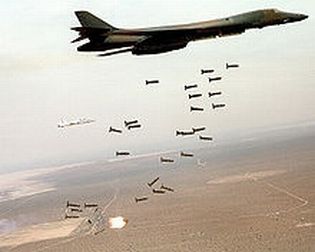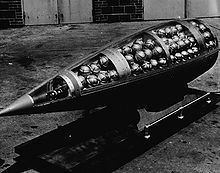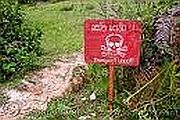
Publisher:
Bonnie King
CONTACT:
Newsroom@Salem-news.com
Advertising:
Adsales@Salem-news.com

~Truth~
~Justice~
~Peace~
TJP
Aug-01-2010 19:19

 TweetFollow @OregonNews
TweetFollow @OregonNews
'Every War Must End'
Chuck Palazzo Salem-News.comLudicrous? Absolutely! An alternative to war? Peace!
 B1-B Lancer dropping cluster bombs on SE Asia |
(DA NANG, Vietnam) - The words of military strategist Fred Ikle. But, tomorrow, August 1, 2010, the new International Ban on Cluster Munitions is lacking three crucial signatures: Those from the United States, Israel, and Russia.
These three countries, well entrenched in war as we speak, and no doubt continuing to proliferate the use of cluster munitions as they engage their enemies at various levels, do not apparently show an interest in this legacy of war. When the war is over, the fighting does not stop. Nor does the suffering of those who participated – many of us are veterans and we know this to be fact.
Many of us are civilians and know this to be fact. But what about the unexploded ordinance? This remnant of war continues to kill – kill and maim the innocents.
More than 30 countries have ratified the Convention on Cluster Munitions, and over 100 have signed it since 2008. But the three holdouts have used cluster bombs in the past decade. Is it a defensive tactic? Russia used cluster bombs in 2008 during its conflict with Georgia – Georgia also used cluster munitions against Russia. Israel in 2006 during its conflict with Hezbollah – Hezbollah also used cluster munitions against Israel.
The United States used cluster bombs in both Afghanistan and Iraq wars – neither the Taliban nor Saddam used cluster bombs against US Troops. Cluster munitions are prohibited for those nations that ratify the Convention on Cluster Munitions. Because cluster bombs release many small bomblets over a wide area they pose risks to civilians both during attacks and afterward. For those who have not ratified? The killing, maiming, total disregard for human life continues.
 Cluster bomb demonstration |
Being attacked in battle then defending one’s life and limb is indeed what is necessary as many combat veterans will attest to. Politics of war aside, combat is survival. But what about the remnants of war? The cluster munitions that are found in various parts of the world on a weekly, if not daily basis? Since the end of the Vietnam War, for example, some estimates indicate more than 100,000 people have been killed from contact with these, and more than 200,000 people have been injured. Sixty-one provinces and cities still have landmines or UXO, and an average of 1,000 people are killed each year because of landmines or UXO. Official figures show that the US dropped 413,130 tons of sub-munitions on Vietnam between 1965 and 1973. This is Vietnam, how about the rest of the world?
 |
What about Laos?
Laos has the dubious distinction of being the world’s most heavily bombed nation. During the period of the American Vietnam War, over half a million bombing missions dropped more than 5 million tons of ordnance on Laos, most of it anti-personnel cluster bombs. Each cluster bomb shell contained hundreds of individual bomblets, “bombies”, about the size of a tennis ball. An estimated 30% of these munitions did not detonate. Ten of the 18 Laotian provinces have been described as “severely contaminated” with artillery and mortar shells, mines, rockets, grenades, and other devices from various countries of origin. These munitions pose a continuing obstacle to agriculture and a special threat to children, who are attracted by the toy like devices. LAO PDR: Cluster casualties continue http://www.alertnet.org/thenews/fromthefield/220485/128040863348.htm
Lebanon?
In the aftermath of the 2006 war between Israel and Lebanon, it is estimated that southern Lebanon is littered with one million undetonated cluster bombs – approximately 1.5 bombs per Lebanese inhabitant of the region, dropped by Israeli Defense Forces in the last days of the war.
Ninety-eight percent of cluster sub-munitions casualties are civilians killed and injured while returning home in the aftermath of conflict or while going about their daily tasks to survive. http://en.handicapinternational.be/Circle-of-Impact–report-on-the-human-impact-of-cluster-bombs_a467.html
UXO
As I researched this article, and through my own personal involvement with professionals and volunteers who fight against and clean-up the UXO disaster, the facts are staggering. UXO – Unexploded Ordinance is a term used to describe “explosive weapons (bombs, bullets, shells, grenades, land mines, naval mines, etc.) that did not explode when they were employed and still pose a risk of detonation, potentially many decades after they were used or discarded”. Cluster bombs and mines certainly account for the majority of these munitions, but there are in fact UXO in the form of World War II bombs and earlier, found each and every year throughout the world. Unexploded ordnance from at least as far back as the American Civil War still poses a hazard worldwide.
The good news is organizations such as MAG – Mines Advisory Group, “clears the remnants of conflict for the benefit of communities worldwide”. http://www.maginternational.org/
The bad news? Countries such as The United States, Israel, and Russia will not sign or ratify the Treaty. In effect giving them carte blanche to continue manufacturing and using cluster munitions well in to the foreseeable future.
This is the real chilling story and fact:
Imagine if, somewhere outside your front door, there is a powerful explosive weapon waiting patiently for you, or a member of your family, to disturb it. Because it’s hidden from view, avoiding it is a constant game of chance.
There could be one of them. There could be 100. You don’t know how many there are and neither does anyone else.
No one really knows how many are left. For that matter, no one really knows how many were dropped or planted to begin with. The numbers I found are indeed estimates – very low and conservative estimates. But others, as the official statistics found regarding The Vietnam War, are closer the real numbers – but still, I am told, grossly understated.
By 1975, 294 cluster munitions had been delivered per square kilometer in Vietnam. This is about two cluster submunitions per person.
 Sign on trail in Laos |
U.S. Ducks As Cluster Bomb Ban Takes Effect
The case against their use is well known: cluster sub-munitions are, in effect, the world’s deadliest duds. The bomblets have a failure rate of up to ten percent by some estimates — and can act as unexploded ordnance, going off in civilian areas after a battle has concluded, similar to landmines. The Cluster Munition Coalition, a group opposed to the weapons, estimates that 60 percent of cluster-bomb casualties are injured “while undertaking their normal activities.”
A dramatic example of the threat of UXO is the wreck of the SS Richard Montgomery off the coast of Kent, which still contains 3000 tons of munitions. When a similar World War II wreck, the Polish Kielce exploded in 1967, it produced an earth tremor measuring 4.5 on the Richter scale.
In 2008, the Pentagon agreed to scale back its use of cluster weapons, pledging not to use any bomb with a failure rate higher than 1 percent after 2018. So why isn’t the U.S. on board with an outright ban?
According to the Pentagon’s 2008 policy, cluster munitions are actually humane weapons. “Because future adversaries will likely use civilian shields for military targets – for example by locating a military target on the roof of an occupied building – use of unitary weapons could result in more civilian casualties and damage than cluster munitions,” the policy claims. “Blanket elimination of cluster munitions is therefore unacceptable due not only to negative military consequences but also due to potential negative consequences for civilians.” In other words, it’s better to use a cluster bomb on enemies using a building than to blow up the entire building.
Cluster opponents don’t buy it. “The vast majority of U.S. allies have banned this weapon,” Thomas Nash, the coordinator of the Cluster Munition Coalition, said in a statement e-mailed to Danger Room. “In line with his rhetoric on multilateralism, Obama needs to bring the U.S. in line with other nations that respect international law and the protection of civilians in armed conflict.”
Alternatives
I have read, as many of you probably have as well, “It’s been suggested that US Forces will not use cluster weapons when working with troops from nations that have signed the new treaty. Development of alternatives, both in the US and elsewhere, is likely to be rapid.”
Ludicrous? Absolutely! An alternative to war? Peace! Why have these three nations not signed the Treaty? To continue the war machine – at any cost.
I urge you all to become acquainted with this very real and life threatening problem. Some of what I wrote above is pure commentary from me. But the majority is fact taken from the references I acknowledge. This is real and this is now. Urge your legislators to become educated on the matter as well. The Pentagon should not lead the US in policy making. In my opinion, the war machine is so huge and out of control, it is time to stop the Generals and Admirals. Cluster munitions, landmines and the like must no longer be manufactured, let alone used. The clean-up must be increased world-wide. But the ongoing use of these weapons of, yes, mass destruction, must end. The World Leaders in War must become the World Leaders in Peace and clean-up the remnants they so often leave behind.
References:
Handicap International
MAG International
The Convention on Cluster Munitions
The International Campaign to Ban Landmines (ICBL)
Wikipedia
Wired
Special thanks to: VeteransToday.com
===================================================
 Chuck Palazzo is a Marine Corps Vietnam Veteran, the Interim Editor for Agent Orange, and a longtime Vietnam Veterans Against the War Member. Chuck Palazzo has spent years since the war studying the impacts and effects of Agent Orange, a defoliant chemical sprayed by the U.S. govt. on the jungles of Vietnam. He says Dioxins have been re-discovered to cause all sorts of damage to humans. These include Heart Disease, Parkinsonism, Diabetes et cetera. Dioxins are already known to produce serious birth defects and a variety of cancers. The chemical is still sold in Third World Countries and is causing the same problems.
Chuck Palazzo is a Marine Corps Vietnam Veteran, the Interim Editor for Agent Orange, and a longtime Vietnam Veterans Against the War Member. Chuck Palazzo has spent years since the war studying the impacts and effects of Agent Orange, a defoliant chemical sprayed by the U.S. govt. on the jungles of Vietnam. He says Dioxins have been re-discovered to cause all sorts of damage to humans. These include Heart Disease, Parkinsonism, Diabetes et cetera. Dioxins are already known to produce serious birth defects and a variety of cancers. The chemical is still sold in Third World Countries and is causing the same problems.
We at Salem-News.com welcome Chuck aboard and look forward to sharing more of his stories with our readers in the future.
Articles for July 31, 2010 | Articles for August 1, 2010 | Articles for August 2, 2010
Quick Links
DINING
Willamette UniversityGoudy Commons Cafe
Dine on the Queen
Willamette Queen Sternwheeler
MUST SEE SALEM
Oregon Capitol ToursCapitol History Gateway
Willamette River Ride
Willamette Queen Sternwheeler
Historic Home Tours:
Deepwood Museum
The Bush House
Gaiety Hollow Garden
AUCTIONS - APPRAISALS
Auction Masters & AppraisalsCONSTRUCTION SERVICES
Roofing and ContractingSheridan, Ore.
ONLINE SHOPPING
Special Occasion DressesAdvertise with Salem-News
Contact:AdSales@Salem-News.com

googlec507860f6901db00.html



Terms of Service | Privacy Policy
All comments and messages are approved by people and self promotional links or unacceptable comments are denied.
Chuck Palazzo August 2, 2010 5:25 pm (Pacific time)
Some more info regarding most effected nations: Statistics are useful although comparisons are sometimes taken out of context, which is not my intent here, because it's absolutely true that Lao PDR was the most heavily bombed country in the world per capita -- given Laos's relatively small population of about 6 million by current estimates. However, it's quite possible that the situation in Vietnam is even more dangerous simply because of the huge difference in population density -- 86 million Vietnamese occupying a fairly small area of highly contaminated lands, so there is likely a higher level of possible exposure just because there are so many more people moving around, thus many more accidents waiting to happen. -Chuck
Vic August 2, 2010 6:18 am (Pacific time)
Great article, Chuck ! How sad that increasingly we are on the wrong side of issues like this. America: A country of basically good people ruled by basically evil people that care about no one or nothing but themselves and their bank accounts.
[Return to Top]©2025 Salem-News.com. All opinions expressed in this article are those of the author and do not necessarily reflect those of Salem-News.com.